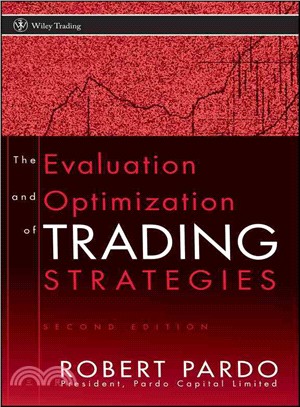| FindBook |
有 1 項符合
THE EVALUATION AND OPTIMIZATION OF TRADING STRATE的圖書 |
 |
THE EVALUATION AND OPTIMIZATION OF TRADING STRATE 作者:Pardo,Robert 出版社:John Wiley & Sons Inc 出版日期:2008-02-08 語言:英文 規格:精裝 / 334頁 / 2.5 x 15.9 x 23.5 cm / 普通級/ 再版 |
| 圖書館借閱 |
| 國家圖書館 | 全國圖書書目資訊網 | 國立公共資訊圖書館 | 電子書服務平台 | MetaCat 跨館整合查詢 |
| 臺北市立圖書館 | 新北市立圖書館 | 基隆市公共圖書館 | 桃園市立圖書館 | 新竹縣公共圖書館 |
| 苗栗縣立圖書館 | 臺中市立圖書館 | 彰化縣公共圖書館 | 南投縣文化局 | 雲林縣公共圖書館 |
| 嘉義縣圖書館 | 臺南市立圖書館 | 高雄市立圖書館 | 屏東縣公共圖書館 | 宜蘭縣公共圖書館 |
| 花蓮縣文化局 | 臺東縣文化處 |
|
|
- 圖書簡介
A newly expanded and updated edition of the trading classic, Design, Testing, and Optimization of Trading Systems
Trading systems expert Robert Pardo is back, and in The Evaluation and Optimization of Trading Strategies, a thoroughly revised and updated edition of his classic text Design, Testing, and Optimization of Trading Systems, he reveals how he has perfected the programming and testing of trading systems using a successful battery of his own time-proven techniques. With this book, Pardo delivers important information to readers, from the design of workable trading strategies to measuring issues like profit and risk. Written in a straightforward and accessible style, this detailed guide presents traders with a way to develop and verify their trading strategy no matter what form they are currently using–stochastics, moving averages, chart patterns, RSI, or breakout methods. Whether a trader is seeking to enhance their profit or just getting started in testing, The Evaluation and Optimization of Trading Strategies offers practical instruction and expert advice on the development, evaluation, and application of winning mechanical trading systems. - 作者簡介
Robert Pardo is a recognized expert in the design and testing of trading strategies and computerized trading applications, and a long-standing professional money manager. He is founder and President of Pardo Capital Limited, a professional money management firm; Pardo Group Limited, a consulting firm; and Pardo Analytics Limited, a proprietary market analysis services firm. Since 1983, Pardo has continuously updated his software as well as designed, programmed, and documented versions of various commercial trading applications. He has worked as a consultant with world-class trading firms such as Goldman Sachs, Transworld Oil, and Daiwa Securities, and created the XT99 trading platform as a joint venture and ongoing strategic alliance between Pardo Capital Limited and Dunn Capital Management. Contact Robert at rep@pardocapital.com, or go to his Web site at http//www.pardocapital.com.
- 目次
Foreword.
Preface.
Acknowledgments.
Introduction.
Chapter 1. On Trading Strategies.
Why This Book Was Written.
Who Will Benefit from this Book?
The Goals of this Book.
The Lay of the Land.
Chapter 2. The Systematic Trading "Edge".
Discretionary Trading.
Raising the Bar.
Verification.
Quantification.
Risk and Reward.
The Performance Profile.
Objectivity.
Consistency.
Extensibility.
The Benefits of the Historical Simulation.
Positive Expectancy.
The Likelihood of Future Profit.
The Performance Profile.
Proper Capitalization.
A Measure of Real-Time Trading Performance.
The Benefits of Optimization.
The Benefits of the Walk-Forward Analysis.
The Advantages of a Thorough Understanding.
Confidence.
Strategy Refinement.
Chapter 3. The Trading Strategy Development Process.
Two Philosophical Approaches to Strategy Development.
The Scientific Approach.
The Path of Empirical Development.
An Overview of the Trading Strategy Design Process.
Step 1: Formulate the Trading Strategy.
Step 2: Translate the Rules into a Definitive Form.
Step 3: Preliminary Testing.
Step 4: Optimize the Trading strategy.
Step 5: the Walk Forward Analysis™.
Step 6: Trade the System.
Step 7: Evaluate Real-Time Performance.
Step 8: Improving the System.
Chapter 4. The Strategy Development Platform.
The Scripting Language.
Diagnostics.
Reporting.
Optimization.
The Objective Function.
Speed.
Automation.
Walk Forward Analysis™.
Portfolio Analysis.
In Conclusion.
Chapter 5. The Elements of Strategy Design.
The Three Principle Components of a Strategy.
Entry and Exit.
Risk Management.
Position Sizing.
An Overview of a Typical Trading Strategy.
A Trade Equals an Entry and an Exit.
Entry Filters.
The Management of Risk.
Trade Risk.
Strategy Risk.
Portfolio Risk.
The Management of Profit.
The Trailing Stop.
Profit Targets.
Position Sizing.
Advanced Strategies.
Summary.
Chapter 6. The Historical Simulation.
The Essential Reports.
The Performance Summary.
The Trade List.
The Equity Curve.
Performance by Period.
The Importance of Accuracy.
Software Limitations.
Rounding Issues.
Phantom Trades.
Price Orders.
Realistic Assumptions.
Price and Trade Slippage.
Opening Gap Slippage.
Opening and Closing Range Slippage.
Slippage Due to Size.
The Significance of Slippage.
Limit Moves.
Major Events and Dates.
Historical Data.
Stock Prices.
Cash Markets.
Futures Markets.
The Continuous Contract.
The Perpetual Contract.
Adjusted Continuous Contracts.
The Size of the Test Window.
Statistical Requirements.
Sample Size and Statistical Error.
How Many Trades?
Stability.
Degrees of Freedom.
Frequency of Trading.
Types of Markets.
The Bull Market.
The Bear Market.
The Cyclic Market.
The Congested Market.
Efficient Markets.
The Life Cycle of a Trading Strategy.
Window Size and Model Life.
Chapter 7. Formulation and Specification.
Formulate the Trading Strategy.
Specification – "Translate" The Idea Into A Testable Strategy.
Make a Vague Idea Precise.
Chapter 8. Preliminary Testing.
Verification of Calculations and Trades.
Calculations.
Trading Rules.
In Summary.
Theoretical Expectations.
Preliminary Profitability.
The Multi-Market and Multi-Period Test.
Selecting the Basket.
Determining the Length of the Test Period.
Segmenting the Data.
The Test.
The Results of the Test.
Chapter 9. Search and Judgment.
Search Methods.
The Grid Search.
The Prioritized Step Search.
Hill Climbing Search Algorithms.
Multi-Point Hill Climbing Search.
Advanced Search Methods.
Simulated Annealing.
Genetic Algorithms.
Particle Swarm Optimization.
General Problems with Search Methods.
The Objective Function.
A Review of a Variety of Evaluation Methods.
Multiple Evaluation Types.
Chapter 10. Optimization.
Optimization contra Overfitting.
A Simple Optimization.
The Optimization Framework.
The Parameters.
The Scan Range.
The Historical Sample.
The Objective Function.
The Optimization Evaluation.
A Multi-Market and Multi-Period Optimization.
The Evaluation of the Optimization.
The Robust Trading Strategy.
The Robust Optimization.
The Statistically Significant Optimization Profile.
The Distribution of the Optimization Profile.
The Shape of the Optimization Profile.
How Does the Strategy Respond to Optimization?
Does the Strategy Deserve Further Development?
Chapter 11. Walk-Forward Analysis.
Is the Trading Strategy Robust?
Robustness and Walk-Forward Efficiency.
The Cure for Overfitting.
A More Reliable Measure of Risk and Return.
Assessing the Impact of Market Changes.
The Best Parameter Set for Trading.
The Theory of Relevant Data.
Peak Performance.
Statistical Rigor.
Shifting Markets.
The Varieties of Market Conditions.
The Walk-Forward.
The Role of the Walk Forward.
Setting Up a Walk-Forward.
An Example of a Walk-Forward Test.
The Walk-Forward Analysis.
The Purpose of the Walk-Forward Analysis.
An Example of a Walk-Forward Analysis.
Is the Strategy Robust?
What Rate of Profit Should We Expect?
What Is the Risk?
Walk-Forward Analysis and the Portfolio.
Chapter 12. The Evaluation of Performance.
The Trading Strategy as an Investment.
The Dimension of Risk.
Compare the Strategy to the Alternatives.
Maximum Drawdown and Trading Risk.
Maximum Drawdown in Context.
Maximum Drawdown and the Trader.
Maximum Run up and the Trader.
Trading Capital and Risk.
Risk Adjusted Return.
Reward to Risk Ratio.
Model Efficiency.
Consistency.
Patterns of Profit and Loss.
Chapter 13. The Many Faces of Overfitting.
What Is Overfitting?
The Abuse of Hindsight.
The Case of the Overfit Forecasting Model.
The Case of the Overfit Trading Model.
The Symptoms of an Overfit Trading Model.
The Causes of Overfitting.
Degrees of Freedom.
Measuring Degrees of Freedom.
Degrees of Freedom, Sample Size and Startup Overhead.
Trade Sample Size.
Optimization Error #1 – Over Parameterization.
Optimization Error #2 –Over Scanning.
The Big Fish in a Small Pond Syndrome.
The Walk-Forward Test.
Chapter 14. Trading the Strategy.
The Mental Aspects of Trading.
Return on Investment.
Poor Strategy.
Market Contraction.
Unseen Market Conditions.
In Conclusion.
Maximum Risk.
Real-time and Evaluation Performance.
Comparing the Evaluation and Trade Profile.
Understanding the Test Profile
Performance Quirks.
The Windfall Profit.
The Losing Run.
Flat Production.
In Conclusion.
Notes.
Index.
|











